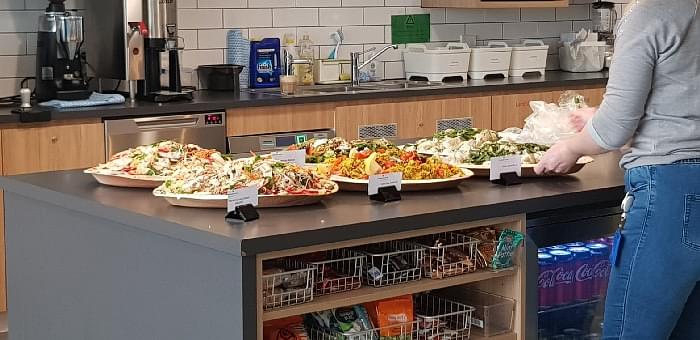Your guide to planning the perfect office lunch
May 24 • 4 min read
For the longest time, nothing binds people together like food. Even the word 'companion' comes from Latin and means 'with bread' — someone friendly with whom to share a meal with.
We now live in a world where food is so easily accessible, with the amount of competing restaurants/cafe's trying to win your business through various aggregators such as UberEats and MenuLog. Food can now be readily delivered to your front-door for you and your friends to eat in front of the television.
In the corporate environment, it isn't so easy. Let's first identify what often goes wrong:
-
Some employees (or even your clients) just don't participate because there is likely nothing they can eat. You may not have catered to their dietary requirements, or they just aren't that interested in the food you've ordered. Often they will go to the restaurant or cafe nearby and order something separately, making you look like you just failed miserably. This often leaves the individual feeling hungry and excluded — the opposite of what a team meal should be all about!
-
Some people eat A LOT. You may have come across some certain employees that fill up their plate to the brim, and sometimes will even come back for seconds. This leaves the other 20 people you've catered for to now be eating less food (or none at all), who may then stitch up a complaint to you. This causes more harm than good, and creates some tension between employees.
-
You may have also come across employees that fill up their plate of food, and bring it straight back to their desks, put their headphones on and avoid spending time with their colleagues all-together. The purpose of team meals is to build relationships, increase collaboration or build a community and if people are eating solo at their desks, then the point of the meal is missed entirely.
-
A heap of food go to waste. Sandwiches and wraps are put in the trashcan, whole pizzas going stale in their boxes, and salads that no one has touched going 'off' by the moment. These expenses add up over time, and your team lunches will become a huge overhead instead of a culture building necessity.
So how do you ensure that corporate meals & team lunches work at your workplace? At Hampr, we're all about thorough & clear planning, days to months before the event. We also ensure that we receive input from your staff, as well as understanding your company's culture & values to ensure that team meals are memorable and satisfying for everyone involved. Dietary requirements are collected early in the planning stages, to ensure that all staff members are catered for with quality food that everyone can enjoy.
Here is how you can ensure that you are serving your company well, and that you're hitting those cultural goals as you're 'dishing' out meals in the office:
-
Collect staff feedback — A lot of the time, staff will talk amongst themselves about the food you've ordered, but seldom will tell the person in charge of organising the food. At Hampr, we encourage staff feedback through our workflow tools, making it easy for you to gain insight to the quality and quantity of your staff lunches. The best thing is that it can be done anonymously through an email survey which is less confronting.
-
Provide professional and adequate food labels & signage. When running a catering event for more than 50 people, its important to provide signage describing the types of cuisines available on the table, as well as indicating the incorporated ingredients to avoid any problems with allergies — Trust me, this will save you a tonne of problems later! Hampr allows you to pre-download and print all the signage and labels online, indicating all dietaries as well as ingredients to make it easy for staff to identify, saving you time and effort but also giving you peace of mind.
-
Traditionally, staff lunches were designed to encourage staff to stay within the office to maximise productivity, however the perception of staff lunches have changed over the past few years, If your office is lacking a bit of culture, or you're trying to promote collaboration between colleagues, then staff lunches is a great way to get people to eat together, and with people they don't usually eat with. Not only are you introducing awesome workplace perks, but you're also standing out from the rest of your competition. How far will you go to create a workplace you love to wake up to every morning?